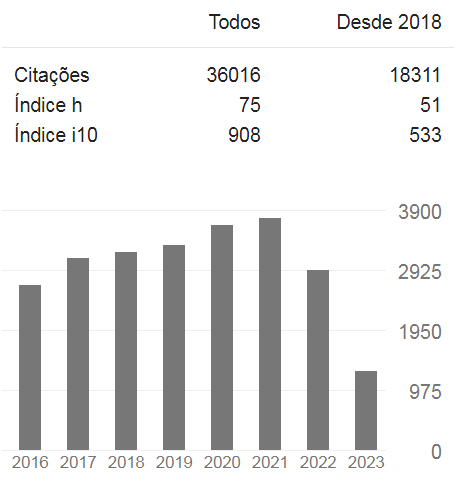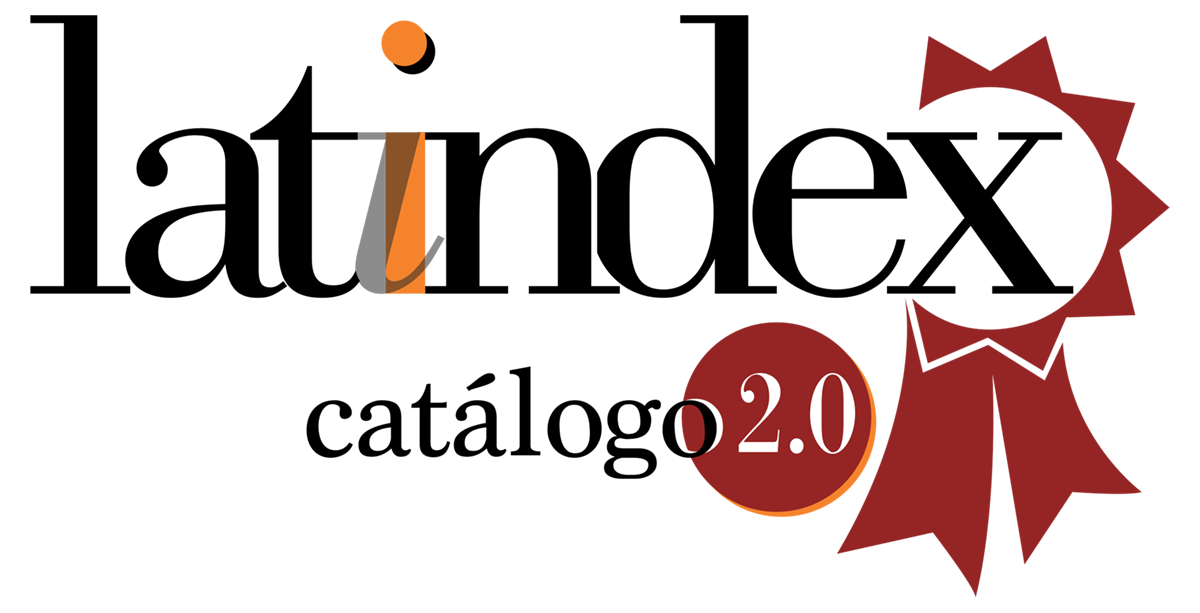Respiratory diseases in children after the administration of 10: valent pneumococcal conjugate vaccine
DOI:
https://doi.org/10.35699/2316-9389.2013.50200Keywords:
Respiratory Diseases, Vaccine, ChildAbstract
Infancy is characterized by a series of changes. Physiologic maturation of the respiratory system as well as internal and external factors makes children under two years of age more susceptible to respiratory diseases. The objective of this study was to identify the occurrence of respiratory diseases after the administration of pneumococcal 10-valent conjugate vaccine in that age group and compare results with clinical and socio-demographic variables. The research was conducted with 90 children that had received at least three dosages of vaccine at Basic Health Units in the city of Imperatriz. Quantitative variables were expressed as frequency and percentage. To test the normality of the variables, the researchers used the chi-square test. The majority of the children aged over 1 year (52.2%); 71.1% were termed by parents/legal guardians as being of a light-brown complexion; family income of 70.0% of the participants was above the minimum wage; legal guardians' schooling ranged from eight to twelve years of education (62.2%); 61.1% of the children lived with smokers; 63.3% had no history of hospitalization. Regarding the occurrence of disease after vaccination, 32.3% developed some respiratory disease (pneumonia, meningitis, otitis media and pharyngitis). The results revealed that the later the vaccination, the lower the vaccine effectiveness. The study results indicate the need to analyse economic, demographic and nutritional aspects that might predispose to respiratory diseases, not only associate the diseases to the effectiveness, duration or age of administration of the pneumococcal 10-valent conjugate vaccine.Downloads
References
Organização Mundial da Saúde. Mudando a história. Genebra: OMS; 2004.
Brasil. Ministério da Saúde. AIDPI Atenção Integral às Doenças Prevalentes na
Infância: curso de capacitação. Introdução: módulo 1. Organização Mundial
da Saúde. Organização Pan-Americana da Saúde. 2ª ed. Brasília: Ministério
da Saúde; 2003.
Yoshioka CRM, Martinez MB, Brandileone MCC, Ragazzi SB, Guerra MLL,
Santos SR. Análise das cepas de Streptococos pneumoniae causadoras de
pneumonia invasiva: sorotipos e sensibilidade aos microbianos J Pediatr (Rio
J). 2010 out; 87(1):70-5.
Bonfin C, Durigon GA, Noegueira ML, Simas PVM, Souza FP. Frequent
respiratory pathogens of respiratory tract infectionsis children attending
daycare centers. J Pediatr. 2011 jun; 87 (5):439-44.
Sigaud CHS, Veríssimo MLR. Enfermagem pediátrica: o cuidado de enfermagem
à criança e ao adolescente. São Paulo: Pedagógica e Universitária; 1996.
Duarte DMG, Botelho C. Perfil clínico de crianças menores de cinco anos
com infecção respiratória aguda. J Pediatr (Rio J). 2000; 76:207-12.
Macedo SEC, Menezes SEC, Albenaz E, Post P, Knost M. Fatores de risco para
internação por doença respiratória aguda em crianças até um ano de idade.
Rev Saúde Pública. 2007 jun; 41(3):351-8.
Lissauer T, Clayder G. Manual Ilustrado de Pediatria. 3ª ed. Rio de Janeiro (RJ):
Elsevier; 2009.
Brasil. Ministério da Saúde. Secretaria de vigilância em saúde. Informe Técnico
da Vacina Pneumocócica 10- Valente (CONJUGADA). Brasília: Secretaria de
Vigilância em Saúde; 2010.
Organização Mundial da Saúde. Nota Informativa. Pneumococcal conjugate
vaccine for childhood immunization. Wkkly Epidemiol Rec. 2007 mar;
(12): 93-107.
Oliveira RG. Black book- Pediatria. 4ª ed. Belo Horizonte: Black Book; 2011.
França E, Souza JM, Guimarães EMA, Colosimo E, Antunes CMF. Association
between socioeconomic factors and infant deaths due to diarrhea,
pneumonia, and malnutrition in a metropolitan area of Southeast Brazil: a
case-control study. Cad Saúde Pública. 2001 nov/dez; 17(6): 1437-47.
Sousa ALTM, Florio A, Kawamoto EE. O neonato, a criança e o adolescente.
São Paulo: EPU; 2001.
Brooks WA, Yunus SM, Mathuram SH. Zinc for severe pneumonia in very
young children: double-blind placebo controlled trial. Lancet. 2004; 3:1683-8.
Paiva MAS, Reis FJC, Fisher GB, Rozov T. Pneumonias na criança. I Consenso
Brasileiro sobre pneumonias. J Pneumol. 1998; 24:101-8.
Pio A. Standard case management of pneumonia in children in developing
countries: the cornerstone of the acute respiratory infection programme.
Bull World Health Organ. 2003 maio; 81: 298-300.
Rudan I, Pinto CB, Biloglav Z, Campbell H. Epidemiology and etiology of
childhood pneumonia. Bull World Health Organ. 2008; 86:408-16.
Silva RMG, Valente JG, Lemos MGF, Sichieri R. Tabagismo no domicilio e
doença respiratória em crianças menores de cinco anos. Cad Saúde Pública.
; 22:579-86.
Brasil. Ministério da Saúde. Secretaria de vigilância em saúde. Informe
Epidemiológico Influenza Pandêmica (H1N1) 2009. 11ª ed. Brasília: Secretaria
de Vigilância em Saúde; 2009.
Dias MCAP, Freire LMS, Franceschini SCC. Recomendações para alimentação
complementar de crianças menores de dois anos. Rev Nutr. 2010 mai/jun;
(3):475-86.
Caetano M, Otiz TTO, Silva SGL, Souza FIS, Sarni ROS. Complementary
feeding: inappropriate practices in infants. J Pediatr. 2010 Mar; 86(3):196-201.
Whitney CG, Hadler J, Harisson LH, Bennet NM, Jackson D. Decline
in invasive pneumococcal disease after the introduction of proteinpolysacharidevonjugate vaccine. N Engl J Med. 2003; 348: 1737-46.
Dominguez A, Salleras L, Fedson DS, Izquierdo C, Ruiz L, Ciruela P, et al.
Effectiveness of pneumococcal vaccination for elderly people in Catalonia
Spain: a case –control study. Clin Infect Dis. 2005; 40: 1250–7.
Sinha A, Levine O, Knoll MD, Muhib F, Lieu TA. Cost-effectiveness of
pneumococcal conjugate vaccination in the prevention of child mortality:
an international economic analysis. Lancet. 2007 Fev; 369:389-96.
Valenzuela MT, Gomes E, Constenla D, Sinha A, Valencia J.E. The burden
of pneumococcal disease among Latin American and Caribbean children:
review of the evidence. Rev Panam Salud Pública. 2009: 25:270-9.
Timo V. Immunogenicity of the 10-valent pneumococcal non
typeableHaemophilusinfluenzae protein D conjugate vaccine (PHiD-CV)
compared to the licensed 7vCRM vaccine. Pediatr Infect Dis J. 2009: 28:66-76.
Ochoa TJ, Egoavil M, Castillo ME, Reyes I, Chaparro, E Silva, W, et al. Invasive
pneumococcal diseases in hospitalized children in Lima,Perú. Rev Panam
Salud Pública. 2010 Jul; 28 (2): 121-7.
Ingels H, Lambirtsen L, Rasmussen JN, Glismann S, Hoffmann S, Andersen
PH. Impact of pneumococcal vaccination in Denmark during the first 3
years after PVC introduction in the childhood immunization programme.
Vaccine. 2012 Jun 6; 30(26):3944-50.
Riva E, Salvini F, Garlashi ML, Rodaelli G, Giovannini M. The status of invasive
pneumococcal disease among children younger than 5 years of age in northwest. Lombardy: Biomed Central; 2012.
Published
How to Cite
Issue
Section
License
Copyright (c) 2013 Reme: Revista Mineira de Enfermagem

This work is licensed under a Creative Commons Attribution 4.0 International License.






































